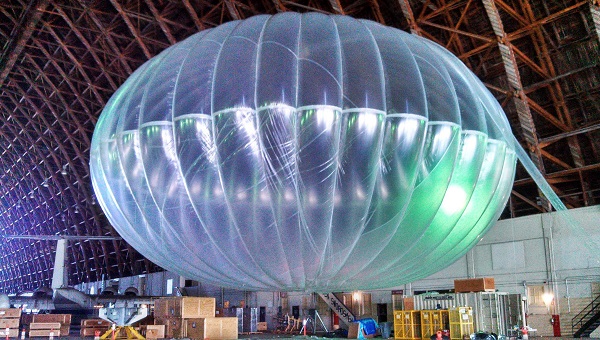Internet balloons to benefit small business—Google

In this March 1, 2013 photo released by Google, a fully inflated test balloon sits in a hangar at Moffett Field airfield, Calif. Google is testing the balloons which sail in the stratosphere and beam the Internet to Earth. AP/Google, Andrea Dunlap
SINGAPORE — Google’s plans to beam the Internet from giant balloons sent to the stratosphere could boost small businesses in rural parts of Asia by connecting them online, the company said Wednesday.
Karim Temsamani, Google’s head of Asia Pacific, said in a speech at the Communicasia conference in Singapore, that the Internet balloons might also facilitate communication during disasters.
Google last week revealed top secret plans to launch thousands of balloons to provide Internet connections to remote parts of the world, allowing the more than four billion people with no access to get online.
Its scientists on Saturday released up to 30 helium-filled test balloons flying 20 kilometres (12.4 miles) above Christchurch in New Zealand, carrying antennae linked to ground base stations.
“What’s devastating is that only a tiny fraction of SMEs (small-medium enterprises) all across Asia are online right now,” Temsamani told the conference.
He said India, one of the region’s emerging economies, has 47 million small businesses, but only one percent are online.
“Getting more businesses online is crucial to every single country in the region,” he said.
The experimental balloon project, called Project Loon, is one way to provide affordable Internet access to “rural, remote and under-served” regions, Temsamani said.
“For farmers in remote rural areas, this would bring market information that allows them to get better prices from merchants,” he added.
The balloons, which once in the stratosphere will be twice as high as commercial airliners and barely visible to the naked eye, will also help in disasters when communication infrastructure is down, Temsamani said.
“For places with few doctors, this could help relay drug information. In disasters, this could help coordinate supplies,” he said.
The balloon network is controlled by ground stations connecting to the local Internet infrastructure and beaming signals to the balloons, which are self-powered by solar panels.
Users below have an Internet antennae they attach the side of their house which can send and receive data signals from the balloons passing overhead.
Some 50 people were chosen to take part in the trial in New Zealand and were able to link to the Internet.
Temsamani cautioned that the project remained in an experimental stage, and would require a lot of work from participating nations.
“These balloons need networks’ co-operation to function, we’re all going to have to work together on this,” he said.
He said Google expects half a billion people in emerging markets worldwide, most of them in Asia, to have Internet access “between now and 2015.”
“These people will drive this transformation even faster. They will not have all the desktop-based habits we’ve developed over the past 10 years,” he added.